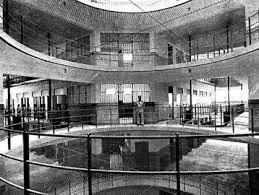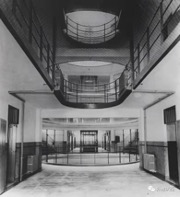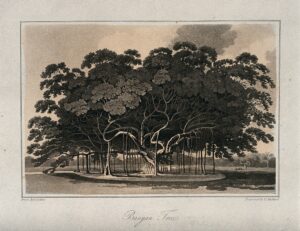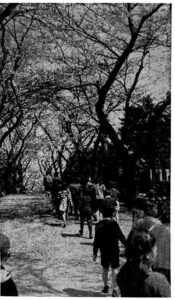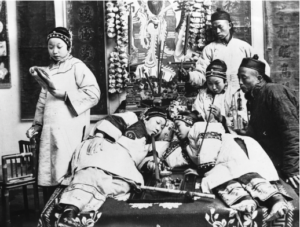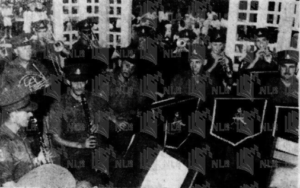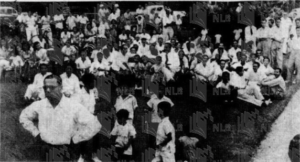The burial ground, throughout the world, has for centuries been considered a sacred place. At the physical level, they provide the setting for laying loved ones to rest peacefully and for paying respects and remembering those who came before us. Throughout history, they can be seen as symbolic sites of power, memory, and identity. Lily Kong and Brenda Yeoh’s The Politics of Landscapes in Singapore: Constructions of ‘Nation’, however, has been a landmark publication analysing their competing role against the will of the ‘modernising state’.1 Using this text as a foundation, this post aims to show that whilst one might expect such personal, spiritual and sacred spaces to contest modernisation and urbanisation, they have offered little resistance, especially in an Asian spatial context.
When studying the physical manifestations of Chinese burial practices and rituals, one is struck by the immensity of tradition, laws and its geomancy. The dead are considered to play an important role in family life, with Chinese custom believing them to have an important role in looking over their ‘earthly descendants’.2 In accordance with feng shui, the Chinese burial space is carefully considered, planned and maintained.3 In China particularly, perhaps more so than in other places, they are sites of familial kinship and loyalty, of home comfort and spirituality and of personal exchange between the living and dead. As Kong and Yeoh have noted the importance of burial site configuration in ensuring ‘benign influences’ are drawn from earth and transmitted to descendants of the dead.4 Any interference with such a custom, would bring risk to the wellbeing of the deceased’s family. With these facts in mind, such sacred sites are widely considered to be immune from external influences and government intervention.
Yet, despite this, such Chinese sites and their stakeholders offered little resistance when modernisation and urbanisation efforts by the Singaporean government commenced in the second half of the 20th century. Such sites, which occupied large areas of physical space, and which many considered to be focusses of disease, proved to be obstacles to expanding townscapes and cityscapes and land acquisition program. This was especially the case with specific regard to Singapore’s relative shortage of land to develop. Whilst some Chinese clans, the YFFK and SHHK sought a level of compensation for their burial grounds being disrupted or moved5, the Singaporean example shows these sacred spaces to have offered little challenge to the will of the state.
To move up the chain of abstraction, it is important to perhaps consider this phenomenon from an alternative, more critical perspective. Whilst Kong and Yeoh note that practices of cremation and the use of columbariums were promoted as a valid and useful alternative to traditional funerary sites, this lack of resistance may also have been a by-product of changing attitudes and perspectives amongst Chinese huangxi themselves. Whilst Kong and Yeoh cite several accounts that highlight the sentimentality in the very beauty, ‘finding’ and ‘activity’ of tending relative’s graves, there is evidence that communities throughout Asia felt less affinity to family and community and instead felt part of a larger, modern and cosmopolitan society. Su Lin Lewis’ Cities in Motion brings to light the rise of ‘globalisation in the public sphere’ and a growing sense of cosmopolitanism throughout Asia.6 Organisations such as the YMCA, YWCA and the Rotary helped foster feelings of community service and international consciousness across Asia. To provide a counter argument to Kong and Yeoh, perhaps communities felt less compelled to engage in the traditions of burial and with ancestral or clan connections and instead felt more kinship to the state.
If one critically unpacks the physical ritual of tending to the dead, such an activity often involves time, offerings and is a practice for entire families or communal groups. However, with modernisation comes displacement, geographical fragmentation and greater restrictions on time. Accompanying the building of new towns comes the relocation of communities and the foundation of new lives, ideas and identities. Affinity to home, albeit not lost, can become more ambiguous and obtruse. Whilst the ritual of visiting and supervising sacred spaces should not be underestimated in the spirituality and comfort it can bring to people, Kong and Yeoh’s analysis reveals the success the Singaporean example had in shaping the material landscape of columbariums to accommodate traditions and still offer meaning for loved one’s of the dead. Indeed, between in 1962, the Mount Vernon Crematorium was performing four cremations per week and by 1995 it was averaging 21 cremations per day.7 Niches could be selected and adjusted to suit the personal preferences of the family, providing an acceptable and more financially viable alternative.8
Whilst this blog has built upon and provided a critique of Kong and Yeoh’s article, further inquiry into the relationship between burial sites, national identity and the state would prove incredibly fruitful. In the contemporary world, disagreements still take place over burial and memorial sites. The removal of George Floyd’s memorial in Minneapolis in 2021 received much criticism with demonstrators protesting that it damaged the city’s collective memory of the incident.9 Such an example proves the power that such sites can have as symbols of resistance, community and identity. Burial grounds have the potential to be places of power, struggle and memory and will continue to provide a fascinating lens through which to study civil autonomy and the will of states.
- Lily Kong and Brenda S. A. Yeoh, The Politics of Landscapes in Singapore: Constructions of ‘Nation’, (Syracuse, 2003) [↩]
- Wilson, B. D., “Chinese Burial Customs in Hong Kong”, Journal of the Hong Kong Branch of the Royal Asiatic Society 1 (1960), p. 115 [↩]
- Michael Paton, Five Classics of Fengshui: Chinese Spiritual Geography in Historical and Environmental Perspective, (2013) [↩]
- Lily Kong and Brenda S. A. Yeoh, The Politics of Landscapes in Singapore: Constructions of ‘Nation’, (Syracuse, 2003), p. 53 [↩]
- Kong and Yeoh, The Politics of Landscapes in Singapore, p. 65 [↩]
- Su Lin Lewis, Cities in Motion, (Cambridge, 2016), p. 120 [↩]
- Kong and Yeoh, The Politics of Landscapes in Singapore, p. 61 [↩]
- Ibid, p. 72 [↩]
- Deena Winter, ‘Minneapolis Removes Memorials and Barricades From ‘George Floyd Square’, (2021), https://www.nytimes.com/2021/06/03/us/george-floyd-memorial-minneapolis.html [↩]
